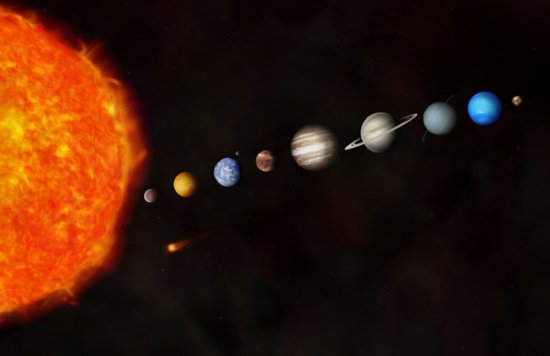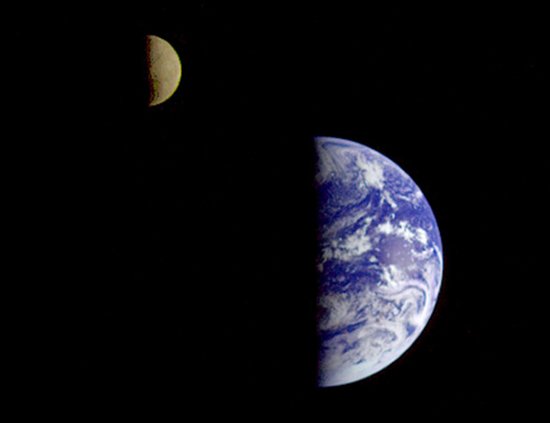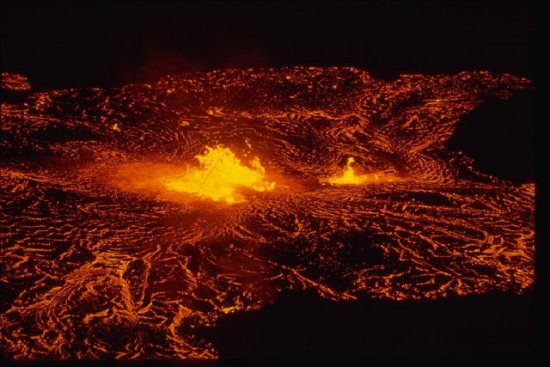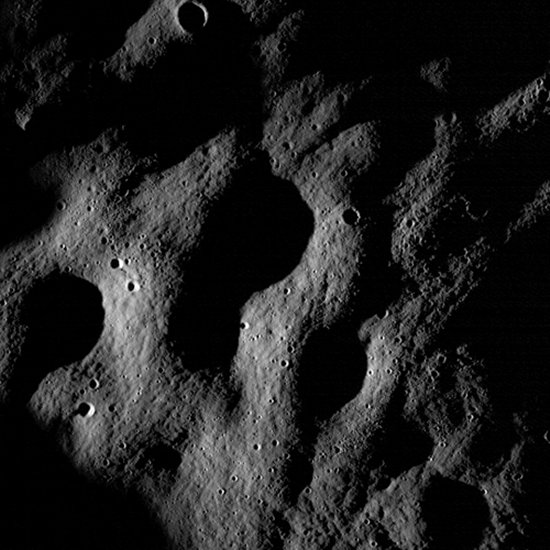Lunar scientist Barbara Cohen explains how our moon functions very much like a planet.
You’ve all probably heard about the International Astronomical Union (IAU) decision to define a planet — probably because it clarified that there is a big belt of icy objects out beyond the orbit of Neptune, and we now know that Pluto is one of thousands of them. The IAU definition also excludes moons from being planets. But did you know our moon functions like a planet? It has a lot to teach us about how planets form and evolve.

Solar system rendering of the eight planets. (Image credit: Koolang Astronomical
Observatory and Science Display Center)
View more blog images
Like the Earth, our moon has a crust, a mantle and a core. These interior layers we think are present on most planets, even if the crust is made of rock or ice. Mars probably has a crust, mantle, and core, and so do Venus and Mercury. The rocks we brought back from the moon from the Apollo missions helped us learn that this process of forming internal layers, or differentiation, is a common process on all planets. So when the moon formed, it formed like a planet.

Another hallmark of planets is that they have active geology. The big, dark splotches you see on the moon’s surface are lava flows. Yes, there were active volcanoes on the moon. There aren’t any volcanic cones, because the lava was very fluid and flowed out through cracks and into low-lying areas. The Apollo samples contain small beads of volcanic glass that tell us there were giant fire-fountains on the moon too. Though volcanic activity on the moon ended about 3 billion years ago, the Apollo missions picked up thousands of earthquakes on the moon, or moonquakes. Moonquakes tell us that the moon is not geologically dead. It’s still acting like a planet today.

Hawaii Volcanoes National Park. (Image credit: Photo Credit: National Park Service)
My favorite part about planets is their impact craters, formed when asteroids or comets whizz into our part of space and collide. When you look at the moon, you can see that it preserves many impact craters on it for researchers like me to study. Did you know that all the craters you see on the moon (and there are hundreds of thousands of them!) had counterparts on the Earth at one point? We don’t see many impact craters on Earth today because the Earth’s crust continually renews itself and erases old rocks and formations. No one rock on Earth is older than 4 billion years. The Earth definitely got beat up by impacts from comets and asteroids in its past — and that record is preserved for us to study on the moon.

For me, the best thing about the moon is that it may not be defined as a planet, but it definitely acts like one. Studying the moon allows us to learn about how all planets work. And because the moon is ancient, it’s like a time capsule back into the early days of our solar system. But, I also love that the moon looks so beautiful reflecting sunlight to us on dark nights and I can’t wait to get more information from our two lunar missions. Godspeed LRO and LCROSS!

What a great article! I thought the moon was just a dead rock similar to Mars’ moons (or maybe I’m wrong about them too). Very cool that there are still moonquakes going on, shows it’s still alive.
All this is allready info fo the LRO LCROSS Mission?
Sweet!!!! > I saw the Launch 😀
Though I probably won’t be able to see anything but a small cloud. (If even that.) I will definetly be waiting with my scope pointed towards the moon this august.
Lucky are those whom job it is to get up every morning and go to work looking at the moon. Sooooo jealous… =D
Very cool. I had no idea the moon was so much like Earth. It makes me wonder, though, how come we’ve named the moons of the other planets, but ours is just “the moon?” Now that we know it acts like a planet, let’s call it something!
I�m fascinated by astronomy!!! And the informations I read here were very helpful!!!
Those photos are not to scale -_-
No offense to the International Astronomical Union (IAU), but if they can’t get it right in this star system we’re going to be challenged to define the rest of the Universe. I can buy the idea that the Moon has some of the same properties that some planets do, but a cat having four legs and a tail does not make it a dog. If Earth were an 8-foot ball, its moon would only be a 2-foot ball. As much as I would like to believe that we live in a binary planetary system, the center of rotation for the orbits is still within the surface of Earth, clearly indicating our Moon’s status as an attached orbiting satellite. Earth’s evolution does indeed depend on tidal effects which have indeed shaped the surface of our planet, but the exact degree of this dependence on our moon can only be guesswork. If I were to describe a true binary planetary system, it would be Pluto and its companion Charon. In short, I think there will be many moons in the solar system – especially around Jupiter and Saturn, which resemble Earth more than the planets they orbit. But as simple as it is, we should define planets as primary objects in orbit of a star once it is proven they are not comets or asteroids. This is a complication, perhaps, when defining objects beyond the PLANET Pluto, so perhaps a third exclusion should be developed for objects in the Oort Cloud/Kuiper Belt but within the shock wave of the heliosphere.
Decades ago a spiritual master in India said that our Moon is a cooled down planet, specifically, a cooled down Earth … that it had been like our Earth. I have always wondered what a study would reveal looking at the Moon from this perspective. Looks like I am about to find out. Exciting.
As an amateur astronomer, I’ve always found the Moon to be one of the first places I look at, & it never fails to deliver both familiar old vistas & new questions. I have a few thoughts on your post:
– While there aren’t peaks like Mount Saint Helens or Vesuvius, what about the domes, which are like the Hawaiian Islands & other shield volcanos? What about TLPs in addition to Moonquakes?
– The Moon & the Earth are a double planet. Pluto & Charon aside, no other world & its satellite are so comparable in diameter. Many years ago, Isaac Asimov pointed out that in the “tug of war” between the Earth & the Sun on the Moon, the Sun is the winner, as opposed to the tugs of war between the other worlds & the Sun on their satellites.
– The LRO pictures of the surface look great-keep them coming!
Hi,
To suggest the Moon and Earth are alike is complete rubbish. One of the latest theories, is that the Earth and a Mars sized planet collided early in the formation of the Solar System, and the remains coalesced to form the Moon. This aside, the Moon has never had an atmosphere or life, and never will. It also moves away from Earth at approx. 3cm every year, and eventually will no longer orbit Earth. Then maybe, when it orbits the Sun on its own, we can call it a dwarf planet? We wont be around to see it though…………
Rick
Hi Rick,
There is no way for us to know if the Moon never had an atmosphere or life millions of years ago, though I agree, it probably never will in the future. And theories are just guesses, not necessarily correct and not proof of anything. But even if the Moon were formed as a result of this collision, there still could have been an atmosphere and life on it in its earlier existence. I think knowing that major fundamental physical properties of the present Moon are like those of the present Earth adds vital information to our understanding of its origin.
It seems certain the Moon is gravitationally bond to the Earth for the foreseeable future. Only an outside force (ref.: Newton) is likely to separate the two. Our best guess is that is how the Moon was created.
The formation of the Moon may well have help make an environment stable enough for life to take hold and develop on our planet. The gravitational bond between the Earth and the Moon has helped to stabilize the tilt of the Earth’s axis and keep the planet’s climate stable moderate.
This has made the Moon an integral and vital component of the Earth. It is one part of a larger interdependent system. The Moon was formed from the Earth and the Earth is dependent on the Moons presence. Maybe the definition of planet will one day include such multiple object systems as a single entity.
Beautiful photos and such an adventure, the solar system is mindblowing! enjoy the trip x
we were wondering if the moon was a planet or not.
we were also wondering if pluto was a planet because people cant seem to make up their minds.
if you dont know, where can we find out?
thanks, grace and kiana
is pluto is asteroid now?
Nice blog! moon is a hanging solid ball in space!
its nice to study it…….
see you later, I want to ask something spacial about Moon!
I’m student of geology…
Thanks!
if part of what defines a planet is layers, what about the gas giants?
IT IS IMPORTANT TO ME TO HAVE GOOD NEW SCIENCE INFORMATION AVAILABLE RIGHT AWAY. THANKS FOR POST THIS AND I WAITING FOR NEXT POST.
well the moon was created by a meteor crashing into earth and thust pushing part of earth away to grab part of our gravitational pull which may have had some life forms but they died cause there was no oxygen.
i like u bolg its cool
it is so interesting how the volcano erupted
WOW! you should like name it or something:-)
Moon teaches the creation of planet.We can say in coming few years moon may become planet.
We may say this by seeing changes in it.
I like your post as you tell every thing about moan and related things.
I would like to read to more from you.
Congratulations for this interesting featured picture! A whole new world…! |
|
|
|
|
|
|
|
i ask is a moon a planet i want a answere
very nice pictures are there.i would like to wish nasa can be succes firm.
I like the moon because at night its bright.
yes the moon is a planet thats interisting
ineed a picture of the moon
Saw in Time Life that the Moon was actually a planet revolving around the Sun, and the Earth and moon actually do a figure 8 around the Sun. Also stated that mankind was not able to digest this information. Digest it or not, if it is true it should be a part of our Learning process until we do get it. Who understand Algebra until we have to go over and over it again until we learn it?
It’ pretty.
ok if a moon revolves around a planet IE. earth,urnus yes uranus has its own moons. But so does pluto and the other planet(zena) so what is your solution to planets v. orbiting moons. if you have a moon your a planet if not then oh well. But both (zena and pluto) have regular orbiting moons. so whats your beef nasa?
I really really love moons..
haha
most of all when I saw the planet mars near it (moon)..
geez..
then the next planet is saturn..
According to the information I gathered they’re 30 degree away from moon..
the mars its like light orang or red..
then saturn is light!
XD
kyaaaa
i want to now if the moon is a planet yes or no?
i want to now if the moon is a planet yes or no?
no,moon is not a planet,but it functions as a planet.Moon is a natural satillite.it rotates around both the sun and the earth.
Did you know people think that the moon is a planet but it is really is a rock and i will be back soon bye
Do you know how old the moon is then here is your chance to find out. The moon 4.5 billion years old and if you want to find out more please just ask.
I think moon is not a planet as far as i know. Its function is just similar like the other planets.
I think it might be it can form million of years from now
Its original name is Lunda .
wow this is really kool 2 learn bout planets & stuff lyk dat…..:P
wow.it’s Very beautiful spectacular
wow., that’s amazing ^_^
I like NASA!!!
thats gud man..
ALL VERY WELL AND GOOD WHAT YOU HAD TO SAY. BUT IN VERY FACT YOU EITHER ARE NOT AWARE OF OR DID BOTHER LISTING FAR MORE PERSUASIVE EVIDENCE THAT SHOWS THAT THE MOON IS JUST AS MUCH A TRUE PLANET OF THE SUN AS THE EARTH OR ANY OF THE OTHER INNER SOLAR SYSTEM PLANETS.
FORGIVE ME IF I DO NOT CHOOSE TO DIVULGE THAT INFORMATION AT THIS POINT, BUT, GOD WILLING, WILL DO SO IN DUE TIME. YOU ARE ON THE RIGHT TRACK, HOWEVER, EVEN THOUGH YOU STILL HAVE SOME DISTANCE TO GO.
why don’t we have advanced space craft on this planet at this time in life with all the technology that’s invented it seems that it could be really easy to invent some more sophisticated space craft instead of the space rockets that are used. why aren’t we building on the moon when we have the capabilities to produce oxygen with water and a renewable energy sources for example solar panels with produce power by the sun.
nice…………………………………………………………….
this website rocks!!!!!!!!!!!
advise, you need help with learning about the solar system u should visit ONLY this web!!!!!!!!!!!!!!!!!!!!!!!!!!!!!!!!!!!!!!!!!!!!!!!!!!!
this is so cool to learn about
iss the moon a planet tell me
eassyyyyyy
Iam really interested in all this and just foud this site So cant wait to learn more